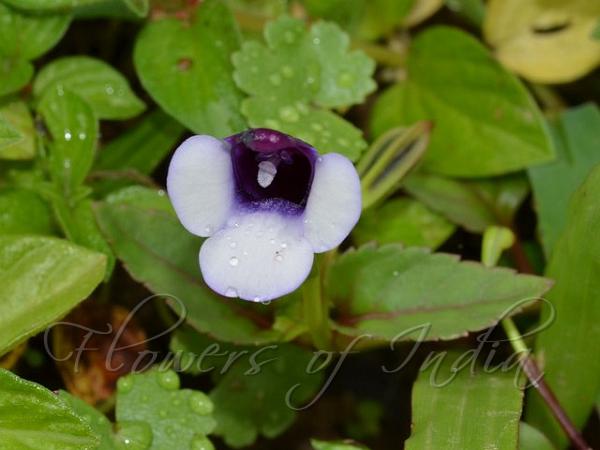|
| Two-Color Wishbone Flower |
|

|

| File size | 89549 |
| Original date | 9/14/14 11:44 AM |
| Resolution | 0 x 0 |
| Flash | Flash fired, return detected |
| Focal length | 60.0mm |
| Exposure time | 1/100s |
| Aperture | 14.0 |
| Focus Distance | |
| Metering Mode | Multi-segment |
| Camera make | NIKON CORPORATION |
| Camera model | NIKON D5100 |
| Sensor type | OneChipColorArea |
|
|
|
|
Photo: |
Botanical name: Torenia bicolor Family: Linderniaceae (Lindernia family)
Two-Color Wishbone Flower is an annual herb growing
in moist and waterlogged areas in the Western Ghats. It is a prostrate
annual herb with stem 4-angled, ciliate along the ridges near the
nodes. Leaves are 1.5-3.5 x 1-2.2 cm, triangular-ovate, base flat or
somewhat heart-shaped, margin toothed, tip pointed, sparsely
velvet-hairy, membranous, stalk 1-1.5 cm long, sparsely airy. Flowers
are borne in leaf axils, solitary or in pairs, on stalks 1.5-3 cm long.
Calyx is 1.2-1.5 cm long, keeled; keel becoming wings on stalks,
glabrous. Flowers are 2-2.5 cm long, deep purple or tube yellowish and
lobes deep purple. Stamens are 4, didynamous; anthers connate in pairs.
The common name “Wishbone Flower” comes from the two stamens united at the anthers, forming a structure that resembles a chicken wishbone. Capsule
is 1-1.5 cm long, oblong, included; fruiting pedicles to 3.5 cm long.
Seeds subglobose, rugose. Two-Color Wishbone Flower is endemic to the
Western Ghats, reported from Goa, Karnataka, Kerala, Maharashtra and
Tamil Nadu. Flowering: All year.
Medicinal uses: Two-Color Wishbone Flower has
been used by Ayurvedic physicians for the treatment of gonorrhoea and
for curing infection of the cornea. A paste made of the plant with
cloves, sandalwood, musk and rose-water is stated to be effective in
curing exanthemata.
Two-Color Wishbone Flower has
been used by Ayurvedic physicians for the treatment of gonorrhoea and
for curing infection of the cornea. A paste made of the plant with
cloves, sandalwood, musk and rose-water is stated to be effective in
curing exanthemata.
Medicinal uses:
 Two-Color Wishbone Flower has
been used by Ayurvedic physicians for the treatment of gonorrhoea and
for curing infection of the cornea. A paste made of the plant with
cloves, sandalwood, musk and rose-water is stated to be effective in
curing exanthemata.
Two-Color Wishbone Flower has
been used by Ayurvedic physicians for the treatment of gonorrhoea and
for curing infection of the cornea. A paste made of the plant with
cloves, sandalwood, musk and rose-water is stated to be effective in
curing exanthemata. | Identification credit: Mayur Nandikar, Anurag Sharma | Photographed at Charmadi Ghat, Karnataka. |
• Is this flower misidentified? If yes,